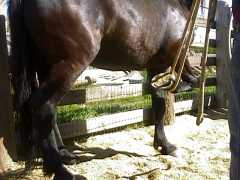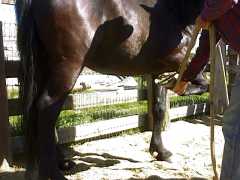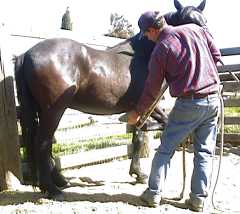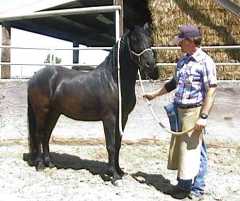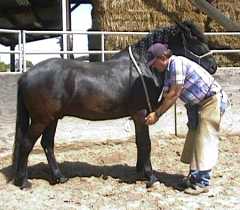Executing "Leg Tugs" |
| WORKING WITH WILD HORSES |
The objective is to trim the feet
(First trim, no lead rope attached)
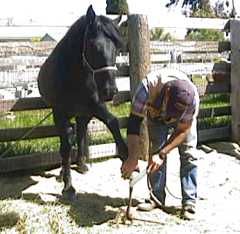
|
When gentling a wild horse you need to reach a point where you
can safely pick up his feet. This process can be dangerous if
the horse is tense and/or reactive when his legs and feet are
handled. A safer way than trying to pick up feet with your hands is
to use a rope in a leg tug fashion.
Not only are you better able to position yourself out of harm's way, but you can retain control over the foot if he swings or moves it, which is often not safe to do by direct hand grip in many circumstances. With horses that are not completely comfortable with humans up close and personal, leg tugs give them a way to process having their legs manipulated without stressing over the fact that someone is tight in their space. Once the horse is relaxed in lifting with the leg tugs, then it is more likely that he will tolerate having his legs touched by human hands during a lift. From that point you can rely less on the rope and more on pressure of the hands until the horse will lift safely using simple hand pressure. (We also find that reinforcing the good behavior with the clicker helps keep the horse focused.) As shown in the top photo, if you approach this process logically and the horse has any sensibility, you can handle those legs and feet without having to overly restrain the horse. (We don't recommend you not use the lead rope, but we took the photo of Max with his foot on the shoeing stand at the end of his first trim, lead rope taken off, to show how cooperative the horse can be when you get things working properly.) |
View of a simple lift
|
| SETTING UP THE ROPE |
|
Getting the rope around the horse's legs can be a bit tricky. If
you're not really handy with a rope, you may wish to avoid accidentally
sending the horse out by banging on his legs in an attempt to get the rope
around them. Likewise, for safety you don't want to be reaching down onto
the ground to pick up a rope that you've flopped between the horse's legs.
One way that we have found to get a front leg wrap where the horse typically stays very calm is to drape the rope over the horse's neck, leaving enough rope hanging from the near side to pass under his leg. The horse should be completely desensitized to the rope and not be bothered by it prior to extending it under his forearm. The next step is to pass the rope under the horse's chest. This maneuver works best if you don't bump the horse with the rope in the process. The horse should not be tied fast so that if he does stress out, he can back away rather than crash into the handler. Once the rope has be passed and picked up, it can be positioned as you wish on the leg. We're not exactly sure why this method works so well but it appears that the horse keys in on the rope over his neck (which at this point should not bother him) and is less sensitive to the rope being passed around his leg. Similarly as the rope is dropped down his leg, it's being slid off his neck. Most horses just look down as if to say, "Oh, it's down there now."
To see more about Max
|
Rope over the neck
|
Return to Leg Tugs PagePress "Back" to return to the page that brought you hereGo to Case Study SectionReturn to Training SectionReturn to Wild Horse MentorsReturn to KBR World of Wild Horses and BurrosGo To
| |

